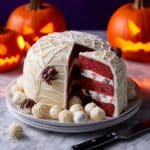Description
This Spider’s Nest Cake is a show-stopping layered chocolate cake with a creepy twist. Featuring soft, moist red-tinted chocolate sponge layers, a spiced cinnamon buttercream, and a hidden cavity filled with coconut-coated white chocolate ‘spider eggs,’ it’s a perfect centerpiece for Halloween or spooky-themed celebrations. The cake is finished with a smooth fondant covering and a cobweb effect made from melted marshmallows, adorned with almond-winged chocolate raisin ‘flies’ and a plastic spider, creating a fun and spooky dessert experience.
Ingredients
Scale
For the cake
- 180g (6oz) butter, softened, plus extra for greasing
- 400g (13oz) caster sugar
- 3 eggs, beaten
- 2 tsp vanilla extract
- 3 x 10g tubes red food-colouring gel
- 500g (1lb) plain flour
- 50g cocoa powder
- 1 x 284ml carton buttermilk
- 1½ tsp bicarbonate of soda
- 1 tbsp cider vinegar
For the buttercream icing
- 300g slightly salted butter, softened
- 225g icing sugar, sifted, plus extra for dusting
- 1½ tbsp milk
- 2 tsp ground cinnamon
- ½ tbsp vanilla extract
For the hidden spider’s eggs
- 3 balls stem ginger, finely chopped
- 175g (6oz) white chocolate, melted
- 50g (2oz) desiccated coconut
For the flies
- 8 chocolate-coated raisins
- 16 flaked almonds
To decorate
- 1 x 1kg block ready-to-roll fondant icing
- 170g (6oz) white mini-marshmallows (for the cobwebs)
Instructions
- Prepare the cake tins and preheat oven: Preheat your oven to gas mark 4, 180°C (fan 160°C). Grease and line three 20cm (8-inch) sandwich tins with baking parchment for easy removal.
- Make the cake batter: Using an electric whisk, beat the softened butter and caster sugar in a large mixing bowl until the mixture is light and fluffy. Gradually add the beaten eggs one at a time, beating well after each addition. Stir in the vanilla extract and red food colouring gel until evenly combined.
- Sift and mix dry ingredients: Sift together the plain flour, cocoa powder, and 1 teaspoon of salt into a separate bowl. Add a third of this flour mixture to the wet ingredients, followed by a third of the buttermilk. Repeat this process two more times until all the flour and buttermilk are fully incorporated.
- Add bicarbonate of soda and vinegar: In a small bowl, mix the bicarbonate of soda with the cider vinegar, then beat this into the cake batter until well combined.
- Bake the cakes: Divide the batter evenly between the prepared tins and bake in the preheated oven for 28-30 minutes, or until a skewer inserted in the center comes out clean. Let the cakes cool in their tins for 10 minutes before turning them out onto a wire rack to cool completely.
- Create cake layers with holes: Once completely cooled, slice each cake horizontally into two even layers, creating a total of six layers. Using an 8cm (3 ½ inch) biscuit cutter, cut a round hole out of the center of four of these layers. Carefully remove the cut-out rounds and crumble them into a bowl; these crumbs will be used for the spider’s eggs.
- Make the buttercream icing: Beat the softened butter in a bowl for 5-8 minutes until soft and fluffy. Gradually add half the sifted icing sugar on low speed, beating for 3-5 minutes, then add the remaining icing sugar. Stir in the milk, ground cinnamon, and vanilla extract until fully combined. Cover and chill the buttercream.
- Prepare the hidden spider’s eggs: Mix the reserved cake crumbs with 3 heaped tablespoons of the buttercream icing and the finely chopped stem ginger until combined. Shape the mixture into small balls around 1.5cm (3/4 inch) wide using clean hands. Place the balls on a tray, cover with clingfilm, and chill for 1 hour (or freeze for 15 minutes).
- Coat the spider eggs: Melt the white chocolate in a heatproof bowl set over simmering water. Dip each cake ball into the melted chocolate, letting the excess drip off, then roll them in the desiccated coconut. Arrange on a tray lined with nonstick baking paper and chill until the coating has set, about 30 minutes.
- Make the flies: Using a sharp knife, carefully slice a small slit on either side of each chocolate-coated raisin and insert flaked almonds to resemble wings. Set aside.
- Assemble the cake: Place one whole cake layer (without a hole) on a cake stand or board. Spread an even layer of buttercream over it. Top with a cake layer that has a hole in the center, then spread more buttercream on this layer. Repeat with the remaining three layers that contain holes, stacking them to form a central cavity. Fill this hollow with as many spider eggs as fit, then top with the final whole cake layer. Spread the remaining buttercream evenly over the top and sides of the cake to create a crumb coat. Chill for at least 30 minutes.
- Decorate with fondant icing: Dust a clean surface with icing sugar and roll out the ready-to-roll fondant icing to a size large enough to cover the entire cake, top and sides. Carefully lift with a rolling pin and drape over the cake. Smooth the fondant gently over the cake and trim any excess icing at the base.
- Create the cobweb effect: Place the white mini-marshmallows in a microwave-safe bowl and heat in 30-second intervals until melted. Stir until cool enough to handle. Use your fingers to pull and stretch the melted marshmallow into thin, web-like strands. Drape these strands artistically all over the cake to mimic a spider web.
- Finish decorating: Attach the almond-winged chocolate raisin flies onto the marshmallow webs by gently pressing them in place. Add a plastic spider atop the cake for the final spooky touch.
Notes
- Ensure the cakes are completely cool before slicing and assembling to prevent the buttercream from melting.
- Use an electric mixer for beating the butter and sugar to achieve a light and fluffy texture for the cake and buttercream.
- When cutting holes in the cake layers, handle gently to prevent breaking the sponge.
- The spider egg balls can be made ahead of time and frozen if needed, just increase chilling time accordingly.
- Be cautious when melting chocolate and marshmallows over heat to avoid burning.
- This cake is best served after chilling for several hours or overnight to allow flavors to meld and buttercream to set.
- For a more dramatic effect, use red food coloring generously to achieve a vivid red color in the sponge.
Nutrition
- Serving Size: 1 slice (1/24 of cake)
- Calories: 568 kcal
- Sugar: 69 g
- Sodium: 0.4 g
- Fat: 23 g
- Saturated Fat: 13 g
- Unsaturated Fat: 7 g
- Trans Fat: 0 g
- Carbohydrates: 88.2 g
- Fiber: 2.4 g
- Protein: 5 g
- Cholesterol: 70 mg

